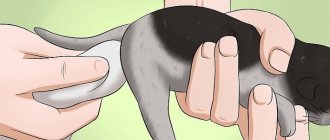Is it worth training?
Before you train your cat to go to the toilet outside, you need to weigh the pros and cons. An animal left unattended is exposed to great dangers. Statistics say that 85% of cats walking unattended inevitably die.
This statistics is confirmed by dozens of arguments. Thus, an animal walking on its own may die as a result of:
- unfriendly people;
- when attacked by dogs;
- as a result of poisoning;
- when falling from heights.
Cat on the street: arguments against
Even if the cat asks to go outside too persistently, you should think carefully before opening the door for him. First of all, it is necessary to take into account that such a change will qualitatively change the pet’s life and will directly affect how and how long it will live. And with the wrong approach, you can significantly shorten the life of your pet!
This is possible because:
- On the street, a cat is exposed to many infections, including rabies (this is why it is so important to give your pet all the necessary vaccinations on time),
- a cat unprepared for the hardships of street life can accidentally eat poison that is spread by animal fighters and become seriously ill or even die,
- on the street it is very difficult for cats to avoid injuries and injuries, and they are harmful not only in themselves: through wounds during fights, dangerous viruses can enter the blood of animals,
- while walking, a cat will inevitably encounter parasites (worms, fleas, ringworm, etc.) - most of them have vaccinations or other preventive measures, but be prepared for the fact that even a healthy walking pet can bring them into your home , infecting other pets or even yourself,
- outdoor cats are often attacked by wild animals, which can either infect them or seriously injure them,
- if the cat is purebred, it can simply be stolen,
- Pets that go outside are more likely than others to die under the wheels of cars or be subjected to cruel treatment by people - they are used to trusting people, so they are often careless.
And, of course, a pet “unprepared” for the hardships of the street can easily catch a cold: temperature changes greatly contribute to this.
Taking this into account, experts say: releasing a domestic cat outside is not a solution to the animal’s behavioral problems. Moreover, this may even be a threat to his life: according to statistics, cats that live on the street or are often there live on average 3-7 years. Domestic cats live to be 14 or more.
Training a kitten
It is known that a kitten remembers all innovations much easier than adult animals. It is much easier to accustom a kitten to the street; they do not have acquired complexes and negative memories. In addition, the baby considers the owner to be his authority, trusting him in everything. You can teach a kitten to go to the toilet outside, starting with walks.
Note! You can keep your pet safe by taking walks and holding the baby in your arms. After getting used to it, it is recommended to accustom the kitten to the harness.
Do not rush or force the kitten. All new skills take time to get used to. If the baby appeared in the house on the eve of winter, then it is recommended to start accustoming him to the street with the arrival of spring. The first trips outside should not be long. It is advisable to carry the kitten in your arms for no more than 10 minutes. It is important to constantly calm and pet your pet.
After the first stages of adaptation, when the baby is gradually accustomed to the harness, you can check whether the animal feels any discomfort. As soon as the baby confidently begins to walk outside, it is necessary, in a place convenient for the owner, to place a tray with cat litter. The tray must be filled with fresh filler, but leave a small part of the old one. This will leave the scent as a guide for the kitten. Gradually you need to replace the filler with soil.
After the kitten begins to confidently go to the litter box outside and rake the ground before going to the toilet, it is necessary to praise the pet. As your pet grows, veterinary experts recommend neutering the cat. Males during puberty constantly fight to defend their territory. Females constantly give birth to offspring. Neutered animals stay close to home and are not bothered by territorial and sexual issues.
How to help your cat get used to it
Despite the fact that cats love freedom and independence, life within four walls greatly affects them. Animals living in apartments are likely to be afraid of the street. Loud noises, large numbers of unfamiliar people and other animals, and open spaces are all likely to put your cat under a lot of stress.
© shutterstock
To avoid this, she should be accustomed to the street gradually, step by step.
Outdoor training for an adult cat
Adult animals living in the private sector go through the adaptation period more easily and begin to go to the toilet outside without problems. Difficulties may arise if the pet is catastrophically afraid of the street. It is also necessary to accustom an adult cat gradually and patiently, like a kitten. In this case, the adaptation time will increase significantly.
The way to train an adult pet to relieve itself does not require taking the tray outside or digging it into the ground. It will be enough to sprinkle the area in the front garden with some of the filler from the tray. It is advisable to choose a deliberately secluded place in the garden that will be convenient for both the owner and the pet (so that no one disturbs the cat at the most crucial moment).
You can treat the selected area with a spray to quickly accustom your pet to the tray.
Cat on the street: arguments for
The main argument of those who regularly let their pet out for a walk and consider it right is simple: cats are very independent natures, and on the street they feel freer, because their space and actions are not limited. Moreover, a cat on the street can also feel happy because:
- there are more opportunities for active activities - outside you can run to your heart's content, climb trees, hunt and do other things cats love,
- there are many relatives living on the street with whom you can sort things out or, on the contrary, “start a family”,
- there is sunlight, a moderate amount of which has a beneficial effect on the health and sleep of the animal,
- on the street, a cat will be able to satisfy its natural curiosity - many different phenomena that will need to be learned can significantly expand the horizons of your pet,
- the street allows animals to demonstrate all their behavioral habits, which are laid down at the level of instincts - scratching various objects with their claws, marking their territory, etc.
Moreover, veterinarians believe that cats need walks because they can add variety to their daily lives. This is very important, because boredom can subsequently become a catalyst for various deviations in the animal’s behavior, which can begin to scratch wallpaper or furniture, intensively lick fur, destroy indoor plants, etc.
This is why animals that are picked up on the street and brought into the house very often want to come back. And if a cat asks to go outside, it is better to either let it out or find something for it to do indoors. Otherwise, she will either be sad or throw out all her energy inside the house, which is sometimes dangerous for the integrity of the things located there.
Rules for retraining a cat after the litter box and in winter
After the litter box, the cat will go outside to the toilet only if it is not afraid to go out and walk on its own. It is quite difficult for an animal accustomed to a litter box to move to a new place. The owner may not notice when the pet went to the toilet, since cats are quite secretive by nature.
You should not expect an animal to go to the toilet while on a leash. In addition, cats do not welcome change, and if they feel danger on the street, they will not go out there.
An important aspect is the time of year outside. Cats will not rummage in wet soil or in the cold, so some difficulties may arise. Some even outdoor cats prefer to dig a hole not in damp soil, but in sand. The problem is completely solvable - you can equip a special box on the street into which you need to pour sand.
It is important to remember that if you live in a private sector or a country house, you should not remove the litter tray in winter. When it's cold outside, animals don't want to go outside, quickly becoming hypothermic.
Note! If the outside temperature is below -15 degrees, the pet is prohibited from being allowed outside. This is especially true for owners of short-haired cat breeds.
Don’t worry that your cat will stop going outside to go to the toilet as it gets warmer. The habit will remain, and the pet will continue to go out to relieve itself. But it’s worth thinking about your pet’s health, because hypothermia can cause serious and dangerous diseases with ensuing complications.
How to train a kitten to go to the “hole” in a private house?
A common reason why kittens refuse to go to the toilet in a hole in the underground is an inconvenient descent. Or rather, the baby will be able to go down, but it’s difficult to get up. Also, although cats see flawlessly in the dark, young cats are alarmed by the darkness.
Try turning on the light first. If the kitten does not want to go underground, you will have to resort to tricks. Attract his attention with something edible, and then throw the food into the “hole”. He'll definitely come down for some tasty treats.
The descent is easier than the ascent; figure out how your pet can climb back up. You may need to leave some auxiliary items.
Nothing is complicated. It is important to take care of your pet and remember to be patient. After a short period of time, the kitten will get used to going outside.
Teaching your pet to leave the apartment on his own
It is possible to teach a cat living in an apartment to go outside on his own, but it is not always recommended. This is especially true in cases where stray dogs may be walking in the yard. Cats may not leave the apartment in a number of cases:
- strong fear (dangers waiting on the street);
- fear of not returning home.
Having decided to teach your cat to walk outside on his own, leaving the apartment, you need to be patient and act gradually. To begin with, you need to pick up the cat and take him out for no more than 5-10 minutes. Then the time is increased, and when the cat gets used to it, you can start learning to walk on a leash.
You need to pick up a special harness at a pet store and take your first walks in an apartment. Veterinary experts do not recommend leaving your pet unattended for a long time, and also not walking it without a harness. On the street, a cat may be frightened by a dog (at best) or by a sharp sound.
What should you think about when letting your cat outside?
If you decide that your pet will walk outside or even live there permanently, you will need to prepare for this. This can be done by taking into account several important aspects:
- the cat will need to have all the necessary vaccinations (against infectious diseases, various viruses) and antiparasitic fur treatment (so that your pet does not suffer from fleas, lice, ticks, etc.),
- the cat needs anthelmintic drugs, and if the animal walks on the street, it will have to be given them once every 3-4 months, regardless of whether you notice symptoms of worms,
- you should think about whether you want your cat to give birth to you: she can do this already at 6-7 months (to avoid this, you should think about castration or sterilization of your pet),
- When releasing a cat onto city streets, it is better to provide the animal with a collar with your address and telephone number or a tag printed on it - this will help if the cat gets lost, and will also indicate that it is domestic.
Teaching a domestic cat to go outside without a litter box
To complete this task, the owner must have a lot of patience. It is necessary to constantly be near the animal, observing the behavior of the pet until it gets used to going to the toilet outside. If you notice that your cat is starting to squat in the litter box, you need to take it outside. You need to take the animal out until it gets used to the fact that there is no litter box in the house, and you need to go to the toilet outside.
Another way to train a domestic cat to go outside without a litter box is to constantly take your pet outside after eating. After eating, you need to go outside with your cat for a walk in the fresh air. Sooner or later, the cat will find a suitable place for its needs, and after 4-6 days, the pet will develop a specific reflex to go outside after eating.
During this period, you can try to let the cat outside as soon as the owner wakes up. For the first 14 days from the start of training, you need to strictly follow the rule in order to develop a reflex. This is much easier to do in a private house than for those living in an apartment building.
An important aspect is the lack of punishment. Even if the animal did everything wrong, it is not recommended to scold the pet. You need to be patient and at the end of the training, the cat will understand what is required of him.
Manifestations of physical maturity
Once they reach puberty, cats begin to behave much more aggressively than male cats. This is expressed in loud screams at night, damage to furniture and wallpaper, and marks throughout the habitat of an animal that has reached a dangerous age. During the period of estrus, the urine of an animal acquires a very pungent and unpleasant odor , it is almost impossible to get rid of it - these are very clear signs of the cat’s puberty. In addition, the beast constantly updates its marks.
The behavior of an animal depends quite strongly on the presence of competitors near it. The more aggressors around, the more nervous the cat began to behave. He hisses and grumbles threateningly, his games resemble hunting.
A loud voice is one way to show rivals who is boss in the house, especially if two animals are in a one-on-one duel.
It should be noted that in addition to being a threat to competitors, cat cries may not be a very good sign. This behavior may be a consequence of the formation of kidney stones in the pet , and not because it has reached a certain age. The sharp edges painfully wound the animal from the inside, causing it to literally scream in pain. That is why any pet’s complaints should be treated carefully and not confuse estrus with a serious problem.
© shutterstock
At what age should you teach?
From two weeks from birth to two months, kittens develop basic life skills. It is this period that should be used with maximum benefit. Therefore, accustoming a one-month-old kitten to a litter box in an apartment will not be difficult. The main thing is to be patient and at first be especially attentive to your small pet.
We need to be patient
For a baby, adapting to a new place of residence is a lot of stress, and getting used to a bowl of food and a toilet will at first become mandatory daily attributes of life. Such skills will allow him to quickly gain confidence and settle into the home.
If kittens live with their mother, then it is from the age of one month that you should start toilet training them. Just at this time they begin to eat regular food or special food. Often, the cat itself teaches children toilet procedures. Then the kitten knows the litter box and, when moving to new owners, will go there if you add the usual litter for it.
What to feed a stray cat from the street
First of all, the new owner, who picked up the kitten on the street, wants to fatten it. Such “nutritional acquaintance” will instill trust in the animal. From the gastronomic abundance you can use:
- Any industrial food, depending on the condition of the teeth - dry or wet. If there is no wet one, you can soak the dry one in water.
- Meat baby food, baby cottage cheese without salt or fillers.
- Chopped meat of chicken, turkey, rabbit, as well as beef, boiled or raw (scalded with boiling water).
It is undesirable to give pork, but raw pork is not allowed: it can be a source of toxoplasmosis.
In addition, pork contains the enzyme thiaminase, which destroys vitamin B1. It is destroyed by heat treatment, but fried meat is not suitable food for a kitten.
What to do
For the owner, there are the following ways to solve the problem of estrus in a pet:
- Sterilize to protect against pregnancy forever. In this case, there is a risk of hormonal imbalance and suppuration of the sutures.
- Use contraceptives. They will dull arousal, but there is a danger of harm to health from taking hormonal drugs.
- Connect with a male. After the birth of kittens, the cat will become calmer and will walk less.
- Distract from sensations during heat. Buy new toys, pay more attention.
If the owner is in doubt about what to do with the pet, it is worth contacting a veterinarian for advice. This will help avoid new health problems.
Little tricks
The life of a cat on the street is full of various rules, and compliance with some of them depends on the owner.
1. Neutered cat and the street
Owners of neutered cats should pay special attention to organizing walks for their pets. According to experts, castrated cats have no smell, so other animals cannot understand whether it is a cat or a cat, and do not touch such a “newbie”: cats simply do not see him as a rival.
However, if a neutered cat behaves aggressively on the street and encroaches on someone else’s territory, a fight cannot be avoided. At the same time, both male and female cats will fight - for the latter, a castrated relative is not at all understandable and is considered something foreign. However, the castrated cat himself will not remain in debt - for him, both male and female cats are the same “border violators”.
2. When and where to go for a walk?
Another important rule concerns the place and time for walks. It is best to take your pet for a walk in quiet places (for example, to a park, if walking animals is allowed there), where there are not large crowds of people and there are few stray animals that can scare a domestic cat. This should be done during the day, and if secluded places are occupied at the height of the day, you can go for a walk in the morning or early evening. In this case, you should avoid that during your walk:
- you did not come close to any thickets - the leash could get tangled in them,
- you did not let the cat go for a minute - a frightened animal can run away,
- a cat sitting in your arms or in a carrier walked on the ground only when it wanted to (it is best to take the cat outside in a carrier, put the carrier on the ground and wait until the pet wants to go out and look around).
3. Pet bell
When the cat has already learned to walk on its own and is not afraid of the street, think about how you will let your pet home and let him out for walks. For residents of private houses, those who live on the first floors have the easiest time - the animal can leave and enter through the window. The rest will have to do this through the door, and in this case it is best to train the cat to meow in front of the door (this is easy to do - at first you need to take the cat one or two floors down, and then call it to you and give a treat when it comes). In the first days of such walks, you can keep the door ajar all the time so that the cat knows that behind it is its home. Finally, for very smart cats, the owners make a special bell at the bottom of the door - a cat that starts scratching at the door, returning home, presses it with its paw and lets you know that it has returned.
4. How to get rid of... prey?
A cat that walks outside has a particularly pronounced hunting instinct - the animal happily hunts birds or rodents and then brings them into the house with no less pleasure. The cat perceives all this as an ordinary game, and is very happy that it can play like this on the street, because at home it is completely deprived of this opportunity. However, why does a cat show its prey to its owners?
According to experts, there are several answers to this question:
- firstly, your pet wants to show you who he managed to catch while hunting,
- secondly, he expects praise for it.
Taking this into account, you should under no circumstances scold a cat for such behavior, because the animal will not even understand what’s going on! In such a situation it is necessary:
- remain completely calm and affectionately thank and praise your pet,
- then carefully remove the bird or rodent from its mouth (if you do this carefully, there is a chance that the “prey” will still be alive, and you can simply release it into the wild),
- After this, you need to pet the cat a little, and then still let her understand that this behavior does not cause you delight (the animal will understand this if you release the prey right in front of its eyes).
In any situation, never raise your voice at your cat or scold it. When hunting, your pet is simply realizing its instincts, and you should not embarrass it by the fact that you do not understand cat nature and are dissatisfied with it.
5. Winter and summer
And, of course, when taking your cat for a walk, it is very important to remember the season! In cold weather, animals get seriously cold, and a cat outside in winter can get a serious cold. In cold weather, it is better not to let your pet out alone, and if you decide to take him for a walk, keep the walks short and provide a blanket for the cat in which you can wrap it, taking your pet in your arms.
On the other hand, a cat outside in the summer may suffer from the heat, so in the heat it is better to hold off on walks. The best option is to let your pet out in the evening or early in the morning and make sure that he does not overheat in the hot sun. Also, on the hottest days, you can simply leave the cat at home, no matter how much it asks to go outside.
By following these simple rules, you can ensure your pet’s “street” life in accordance with all the rules. Such a life will certainly be comfortable for your cat, and will also be as safe as possible for her. And the more you think about the health and life of your pet, the greater the chance that everything will always be fine with him.
Tweet
Join us in social networks:
What to do if he doesn’t walk?
You can correctly train a kitten to use the toilet using the opposite method - place bowls with food and water in the place that he has chosen for his needs. His cat instincts will not allow him to go to this place anymore. Watch the animal - if it wants to go to the toilet, it begins to give signals. Scratching, fussing, sniffing or meowing? Immediately place the cat in the tray, show him that the litter can be dug, and do not let him out until the procedure is completed.
Perseverance and patience will give positive results
To make sure he goes into the litter box next time, you can dip a napkin in the cat's feces and place it in the litter box. The kitten will find its toilet by smell. There are times when kittens do not go to the litter box only because they do not like a particular type of litter.
If you can't get him used to the tray, try experimenting with different types of litter. You can also put several trays in different places so that the new member of the household can choose his own place.
LiveInternetLiveInternet
Quote from Aleks-N
Read in full In your quotation book or community!
Should a cat be allowed outside
? Should a cat be allowed to walk outside from time to time, and if so, for how long? This is one of the very important questions, the answer to which every cat owner must find on their own. There are many pros and cons to consider on this topic, and these pros and cons will need to be weighed more than once before making a final decision.
Cat on the street: arguments for
The main argument of those who regularly let their pet out for a walk and consider it right is simple: cats are very independent natures, and on the street they feel freer, because their space and actions are not limited. Moreover, a cat on the street can also feel happy because:
- there are more opportunities for active activities - outside you can run to your heart's content, climb trees, hunt and do other things cats love,
- there are many relatives living on the street with whom you can sort things out or, on the contrary, “start a family”,
- there is sunlight, a moderate amount of which has a beneficial effect on the health and sleep of the animal,
- on the street, a cat will be able to satisfy its natural curiosity - many different phenomena that will need to be learned can significantly expand the horizons of your pet,
- the street allows animals to demonstrate all their behavioral habits, which are laid down at the level of instincts - scratching various objects with their claws, marking their territory, etc.
Moreover, veterinarians believe that cats need walks because they can add variety to their daily lives. This is very important, because boredom can subsequently become a catalyst for various deviations in the animal’s behavior, which can begin to scratch wallpaper or furniture, intensively lick fur, destroy indoor plants, etc.
This is why animals that are picked up on the street and brought into the house very often want to come back. And if a cat asks to go outside, it is better to either let it out or find something for it to do indoors. Otherwise, she will either be sad or throw out all her energy inside the house, which is sometimes dangerous for the integrity of the things located there.
Cat on the street: arguments against
Even if the cat asks to go outside too persistently, you should think carefully before opening the door for him. First of all, it is necessary to take into account that such a change will qualitatively change the pet’s life and will directly affect how and how long it will live. And with the wrong approach, you can significantly shorten the life of your pet!
This is possible because:
- On the street, a cat is exposed to many infections, including rabies (this is why it is so important to give your pet all the necessary vaccinations on time),
- a cat unprepared for the hardships of street life can accidentally eat poison that is spread by animal fighters and become seriously ill or even die,
- on the street it is very difficult for cats to avoid injuries and injuries, and they are harmful not only in themselves: through wounds during fights, feline AIDS viruses can enter the blood of animals, which affects 14% of animals,
- while walking, a cat will inevitably encounter parasites (worms, fleas, ringworm, etc.) - most of them have vaccinations or other preventive measures, but be prepared for the fact that even a healthy walking pet can bring them into your home , infecting other pets or even yourself,
- outdoor cats are often attacked by wild animals, which can either infect them or seriously injure them,
- if the cat is purebred, it can simply be stolen,
- Pets that go outside are more likely than others to die under the wheels of cars or be subjected to cruel treatment by people - they are used to trusting people, so they are often careless.
And, of course, a pet “unprepared” for the hardships of the street can easily catch a cold: temperature changes greatly contribute to this.
Taking this into account, experts say: releasing a domestic cat outside is not a solution to the animal’s behavioral problems. Moreover, this may even be a threat to his life: according to statistics, cats that live on the street or are often there live on average 3-7 years. Domestic cats live to be 14 or more.
What should you think about when letting your cat outside?
If you decide that your pet will walk outside or even live there permanently, you will need to prepare for this. This can be done by taking into account several important aspects:
- the cat will need to have all the necessary vaccinations (against infectious diseases, various viruses) and antiparasitic fur treatment (so that your pet does not suffer from fleas, lice, ticks, etc.),
- the cat needs anthelmintic drugs, and if the animal walks on the street, it will have to be given them once every 3-4 months, regardless of whether you notice symptoms of worms,
- you should think about whether you want the cat to bring you offspring: she is able to do this already at 6-7 years of age (to avoid this, you should think about castration or sterilization of your pet),
- When releasing a cat onto city streets, it is better to provide the animal with a collar with your address and telephone number or a tag printed on it - this will help if the cat gets lost, and will also indicate that it is domestic.
How to accustom a cat to the street?
This needs to be done gradually. A kitten should be taught to walk from the age of 3-4 months, when it has already received the necessary vaccinations. The sequence of training is as follows:
- rehearse a walk down the street with your pet - put a harness and leash on the cat and accustom him to this accessory by leading the cat around the house,
- when your pet gets used to such unusual equipment, introduce him to the yard,
- then show him the street with all its dangers,
- after this, the kitten should be shown the way to the entrance of the house, and from there to your apartment (the opinion that cats easily find their way home is wrong - only those who have already adapted to the street do this).
At the first stage, you will need to accustom your cat to a leash and harness. A collar for cats is not suitable because they have a more delicate and thin neck than dogs, and the collar can seriously damage it. Harnesses (special straps that cover the pet in the area of the shoulder blades and fasten on the neck or tummy) are not capable of this and, in addition, they do not allow the cat to slip out of them.
To help your cat get used to the harness faster, you should choose an accessory made of lightweight material (cotton or nylon), and also make sure that both the harness and the leash are as light as possible. You can use roulette leashes for small breed dogs.
If your pet is already a year old or more, and he has never been outside, it is better not to let him out at all. Such a walk will be a real stress for the animal. On the other hand, the younger the kitten, the greater the chance that it will quickly adapt to the street.
Also, if you are wondering how to tame a cat outdoors, remember: an adapted animal may not appear at home for several days, especially if it is March! But at the same time, if the cat has been gone for more than 2-3 days, it is better to independently visit the places where these animals gather (basements, certain areas of courtyards, entrances) and look for your pet there. Also, do not be surprised if one day your pet returns home bitten, hungry and scratched - such are the hardships of street life, and if you have chosen it for your pet, all that remains is to care for it afterwards.
How to wean a cat off the street?
If you suddenly decide that you need to stop walking (or you picked up a cat from the street and don’t want her to return there), you will definitely have to think about how to wean the animal from “free life”. This is very important, because a cat that is used to living outdoors will have a hard time adapting to the house. However, this problem is completely solvable. You just need to follow a few instructions:
- give the cat her own territory where she can walk and play as much as she wants,
- arrange places on which the animal can calmly climb and on which it can sharpen its claws, and you will satisfy its habits, which are easily implemented on the street,
- for a domestic cat, you can purchase a special gaming complex that allows you to satisfy all the needs of the animal,
- let your pet go for a walk on the balcony (provided that it is fenced and the cat will not run away),
- protect the vents and windows with nets or bars so that the cat does not intentionally or accidentally leave your house,
- prepare the cat litter by filling it not with litter, but with sand or earth - this will be more consistent with the living conditions to which your pet is accustomed,
- diversify the life and nutrition of your pet - cats that have been outside are more active, and more domestic ones need various useful and nutrients, and to provide them with them, try growing grass for cats at home and buying vitamins,
- Pay more attention to your pet, playing with him as often as possible.
And remember: you should never transfer your emotions to the emotions of animals. If you see that a cat is sitting sadly on the windowsill and looking outside, this does not mean that it is eager to go there. Typically, such “get-togethers” only mean that the animal is simply observing what is happening: for cats this is a great way to relax. And if animals receive sufficient physical activity and a balanced diet, they have no need to walk outside.
Little tricks
The life of a cat on the street is full of various rules, and compliance with some of them depends on the owner.
Neutered cat and the street
Owners of neutered cats should pay special attention to organizing walks for their pets. According to experts, castrated cats have no smell, so other animals cannot understand whether it is a cat or a cat, and do not touch such a “newbie”: cats simply do not see him as a rival.
However, if a neutered cat behaves aggressively on the street and encroaches on someone else’s territory, a fight cannot be avoided. At the same time, both male and female cats will fight - for the latter, a castrated relative is not at all understandable and is considered something foreign. However, the castrated cat himself will not remain in debt - for him, both male and female cats are the same “border violators”.
When and where to go for a walk?
Another important rule concerns the place and time for walks. It is best to take your pet for a walk in quiet places (for example, in a park), where there are not large crowds of people and there are few stray animals that can scare a domestic cat. This should be done during the day, and if secluded places are occupied at the height of the day, you can go for a walk in the morning or early evening. In this case, you should avoid that during your walk:
- you did not come close to any thickets - the leash could get tangled in them,
- you did not let the cat go for a minute - a frightened animal can run away,
- a cat sitting in your arms or in a carrier walked on the ground only when it wanted to (it is best to take the cat outside in a carrier, put the carrier on the ground and wait until the pet wants to go out and look around).
Pet call
When the cat has already learned to walk on its own and is not afraid of the street, think about how you will let your pet home and let him out for walks. For residents of private houses, those who live on the first floors have the easiest time - the animal can leave and enter through the window. The rest will have to do this through the door, and in this case it is best to train the cat to meow in front of the door (this is easy to do - at first you need to take the cat one or two floors down, and then call it to you and give a treat when it comes). In the first days of such walks, you can keep the door ajar all the time so that the cat knows that behind it is its home. Finally, for very smart cats, the owners make a special bell at the bottom of the door - a cat that starts scratching at the door, returning home, presses it with its paw and lets you know that it has returned.
How to get rid of... prey?
A cat that walks outside has a particularly pronounced hunting instinct - the animal happily hunts birds or rodents and then brings them into the house with no less pleasure. The cat perceives all this as an ordinary game, and is very happy that it can play like this on the street, because at home it is completely deprived of this opportunity. However, why does a cat show its prey to its owners?
According to experts, there are several answers to this question:
- firstly, your pet wants to show you who he managed to catch while hunting,
- secondly, he expects praise for it.
Taking this into account, you should under no circumstances scold a cat for such behavior, because the animal will not even understand what’s going on! In such a situation it is necessary:
- remain completely calm and affectionately thank and praise your pet,
- then carefully remove the bird or rodent from its mouth (if you do this carefully, there is a chance that the “prey” will still be alive, and you can simply release it into the wild),
- After this, you need to pet the cat a little, and then still let her understand that this behavior does not cause you delight (the animal will understand this if you release the prey right in front of its eyes).
In any situation, never raise your voice at your cat or scold it. When hunting, your pet is simply realizing its instincts, and you should not embarrass it by the fact that you do not understand cat nature and are dissatisfied with it.
Winter and summer
And, of course, when taking your cat for a walk, it is very important to remember the season! In cold weather, animals get seriously cold, and a cat outside in winter can get a serious cold. In cold weather, it is better not to let your pet out alone, and if you decide to take him for a walk, keep the walks short and provide a blanket for the cat in which you can wrap it, taking your pet in your arms.
On the other hand, a cat outside in the summer may suffer from the heat, so in the heat it is better to hold off on walks. The best option is to let your pet out in the evening or early in the morning and make sure that he does not overheat in the hot sun. Also, on the hottest days, you can simply leave the cat at home, no matter how much it asks to go outside.
By following these simple rules, you can ensure your pet’s “street” life in accordance with all the rules. Such a life will certainly be comfortable for your cat, and will also be as safe as possible for her. And the more you think about the health and life of your pet, the greater the chance that everything will always be fine with him.
Source
...and another video on the topic:
Domestic cat and street: pros and cons
Should we let domestic cats out for a walk or not? The opinions of their owners on this issue vary. Some argue that the animal is happy to be free at least for a while. Others are convinced that nothing but trouble awaits their pets outside.
Arguments from supporters of the festivities:
- outside the cat will run, climb trees, hunt birds or butterflies;
- in freedom you can meet and “communicate” with your fellow tribesmen;
- on a walk you come across things that are not at home (felines are very inquisitive by nature);
- sun in moderate doses has a beneficial effect on the physical health of the pet;
- no one will scold the animal when it decides to sharpen its claws or mark its territory.
What is against walking is that:
- in nature, a variety of infections lie in wait for a domestic animal;
- in addition to viruses, a pet can pick up parasites (fleas, etc.) on the street, some of which are transmitted to humans;
- when free, it is impossible for a cat to avoid injury (for example, when attacked by wild relatives or dogs);
- our pets don’t know what a car is and can die under the wheels.











